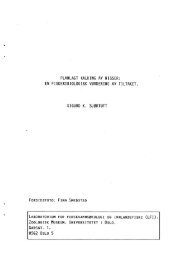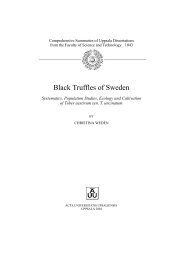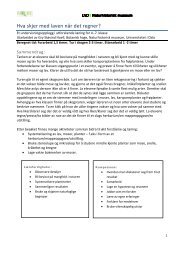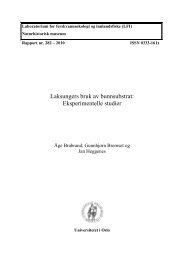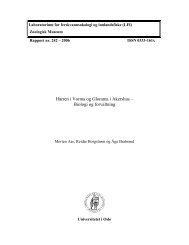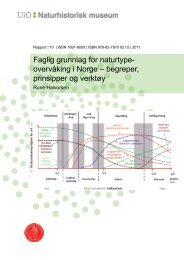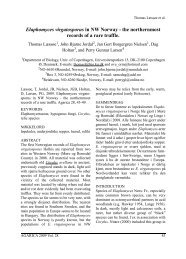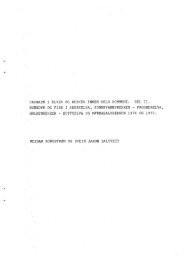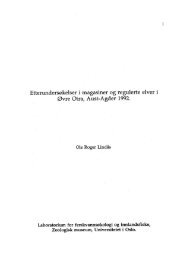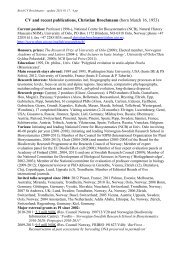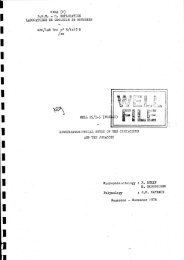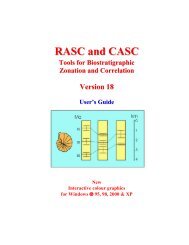Truffle trouble: what happened to the Tuberales?
Truffle trouble: what happened to the Tuberales?
Truffle trouble: what happened to the Tuberales?
- TAGS
- truffle
- www.nhm.uio.no
Create successful ePaper yourself
Turn your PDF publications into a flip-book with our unique Google optimized e-Paper software.
1084 T. Læssøe, K. Hansen<br />
Besides <strong>the</strong> molecular results <strong>the</strong> highly inflated exipular cells<br />
also suggest this fungus belongs <strong>to</strong> Pezizaceae ra<strong>the</strong>r than<br />
Tuberaceae. The exact placement of Eremiomyces within Pezizaceae<br />
is not resolved in our analyses, but it is likely among members<br />
of <strong>the</strong> P. depressa–Ruhlandiella, Plicaria–Hapsidomyces or P.<br />
phyllogena lineages (<strong>the</strong> inclusive clade A in Hansen et al. 2005).<br />
Hydnobolites Tul. & C. Tul. 1843 (Fig 5C)<br />
Type: Hydnobolites cerebriformis.<br />
This genus apparently has only two accepted species,<br />
H. cerebriformis from Europe and H. californicus from North<br />
America. The type species has saccate, amyloid [when pretreated<br />
in potassium hydroxide (KOH)] asci formed in poorly<br />
defined hymenia, without well-differentiated paraphyses, in<br />
brain-like, pale ascomata. The spores are globose with a reticulate<br />
and spinulose ornament. The genus was previously placed<br />
in <strong>the</strong> Tuberaceae (Gilkey 1955; Korf 1973a; Castellano et al. 2004)<br />
or in <strong>the</strong> Terfeziaceae (Hawker 1954; Trappe 1971, 1979). Trappe<br />
(1979) regarded Hydnobolites <strong>to</strong> be close <strong>to</strong> Pachyphloeus and<br />
Terfezia (Fig 5D). Kimbrough et al. (1991) suggested a placement<br />
in <strong>the</strong> Pezizaceae based on ultrastructural observations of septal<br />
pores. They also found <strong>the</strong> asci <strong>to</strong> be weakly amyloid after treatment<br />
in 2 % KOH. No molecular data are available for Hydnobolites,<br />
and <strong>the</strong> placement is mainly based on <strong>the</strong> amyloid asci and<br />
<strong>the</strong> suggested close relationship <strong>to</strong> Pachyphloeus and Terfezia.<br />
Hydnotryopsis Gilkey 1916<br />
Type: Hydnotryopsis setchellii.<br />
Gilkey (1954) later abandoned <strong>the</strong> genus and placed it in<br />
Choiromyces. In agreement with Hansen et al. (2005), Hydnotryopsis<br />
setchelli and an unnamed Hydnotryopsis are suggested<br />
as closely related <strong>to</strong> <strong>the</strong> near hypogeous Sarcosphaera coronaria<br />
(Figs 2 and 5A-B). The constraint analyses forcing <strong>the</strong> two Hydnotryopsis<br />
species <strong>to</strong> be monopyletic could not be rejected<br />
(Table 1). Hydnotryopsis was placed in <strong>the</strong> Pezizaceae by Fischer<br />
(1938), and based on <strong>the</strong> diffusely amyloid asci, followed by<br />
e.g. Trappe (1975c, 1979). The solid ascomata have a peridium<br />
of globose cells, and asci and paraphyses in a hymenial<br />
configuration.<br />
Kalaharituber Trappe & Kagan-Zur 2005<br />
Type: Kalaharituber pfeilii (syn. Terfezia pfeilii).<br />
Ferdman et al. (2005) demonstrated (using ITS and LSU) <strong>the</strong><br />
non-monophyletic nature of Terfezia and erected Kalaharituber<br />
for a sou<strong>the</strong>rn African desert truffle originally described as<br />
T. pfeilii (basionym in error given as Tuber pfeilii). No epigeous<br />
representatives were included in <strong>the</strong>ir analyses. Our analyses<br />
indicate a relationship with <strong>the</strong> epigeous Iodowynnea (PB 75 %,<br />
Fig 2). Taylor et al. (1995) discussed <strong>the</strong> biology of K. pfeilii and<br />
suggested it could be mycorrhizal with species of Acacia, although<br />
a strong association with grasses was noted.<br />
Mattirolomyces E. Fisch. 1938<br />
Type: Choiromyces terfezioides (syn. Mattirolomyces terfezioides,<br />
Terfezia terfezioides).<br />
This genus was reinstated by Percudani et al. (1999) and accepted<br />
as such by Diéz et al. (2002) and Ferdman et al. (2005), after<br />
having been sunk under Terfezia, where it still recides in e.g.<br />
Montecchi & Sarasini (2000). Unlike species of Terfezia, M. terfezioides<br />
occurs in woodland or in ruderal habitats ra<strong>the</strong>r than in<br />
deserts (e.g. Montecchi & Sarasini 2000). Kovács et al. (2003)<br />
reviewed <strong>the</strong> mycorrhizae studies on Mattirolomyces and similar<br />
taxa and concluded that <strong>the</strong>re is no clear evidence for a mycorrhizal<br />
function, and an ec<strong>to</strong>mycorrhizal ana<strong>to</strong>my does not<br />
develop (with Robinia or Helian<strong>the</strong>mum ovatum) but, instead, an<br />
ana<strong>to</strong>my referred <strong>to</strong> as ‘terfezioid’. Kovács et al. (2007) maintained<br />
that <strong>the</strong> trophic strategy of this fungus remains ambiguous.<br />
It forms sclerotia in <strong>the</strong> same manner as certain species<br />
of Morchella. Although <strong>the</strong> position of Mattirolomyces is uncertain<br />
in our analyses, constraint analyses forcing Mattirolomyces<br />
<strong>to</strong> group with Terfezia were rejected (Table 1). Healy (2003) described<br />
an additional American species, but based on molecular<br />
data (R. Healy, K. Hansen and G. Kovács, unpublished<br />
results) this species is not a member of Mattirolomyces.<br />
Mycoclelandia Trappe & Bea<strong>to</strong>n 1984 (syn. Clelandia)<br />
Type: Clelandia arenacea (syn. M. arenacea).<br />
Bea<strong>to</strong>n & Weste (1982) revised <strong>the</strong> two known species (as<br />
Clelandia) and Trappe & Bea<strong>to</strong>n (1984) replaced <strong>the</strong> invalid<br />
homonym Clelandia for Mycoclelandia. The asci stain strongly<br />
or diffused blue in iodine solutions. There are no sequences<br />
available, but based on <strong>the</strong> known morphological features<br />
<strong>the</strong> genus clearly belongs in <strong>the</strong> Pezizaceae.<br />
Pachyphloeus Tul & C. Tul. 1844 (syn. Pachyphlodes, Cryptica)<br />
Type: Pachyphloeus melanoxanthus.<br />
The ascomata typically have an apical depression or pore<br />
connecting <strong>to</strong> a few open veins. The peridium is verrucose<br />
and contains globose cells. Trappe (1979) placed <strong>the</strong> genus in<br />
<strong>the</strong> Terfeziaceae and gave <strong>the</strong> above synonymy (Trappe<br />
1975c). It had mainly been treated within <strong>the</strong> Tuberaceae (e.g.<br />
Knapp 1951; Korf 1973a). Amyloid asci occur in some species<br />
of Pachyphloeus (e.g. <strong>the</strong> type species), and based on this and<br />
ana<strong>to</strong>mical features <strong>the</strong> genus was placed in <strong>the</strong> Pezizaceae<br />
(Dissing & Korf 1980). This has been confirmed by molecular<br />
data (Norman & Egger 1999; Percudani et al. 1999; Hansen<br />
et al. 2005). Phylogenetic analyses of LSU suggest that <strong>the</strong><br />
type species is more closely related <strong>to</strong> species of Scabropezia<br />
than <strong>to</strong> o<strong>the</strong>r species of Pachyphloeus (PB 89 %, PP 100 %, Fig 2).<br />
Also, constraint analyses forcing <strong>the</strong> three included Pachyphloeus<br />
spp. <strong>to</strong> be monophyletic were rejected (Table 1). This<br />
suggests that Scabropezia may be a synonym of Pachyphloeus.<br />
Peziza Fr. 1822 (syn. Hydnoplicata)<br />
Type (lec<strong>to</strong>type): Peziza vesiculosa.<br />
Several hypogeous species, with passive spore dispersal,<br />
have been accepted in <strong>the</strong> o<strong>the</strong>rwise epigeous, apo<strong>the</strong>cial<br />
genus Peziza. Trappe (1979) noted six hypogeous species in<br />
Peziza and recently Peziza infossa (syn. P. quercicola) was added<br />
(Fogel & States 2002, 2003). Although this latter species is described<br />
as having operculate asci, no active spore discharge<br />
had been observed. Peziza has been demonstrated several<br />
times, using molecular phylogenetics, <strong>to</strong> be non-monophyletic<br />
(see above under Pezizaceae). The two pezizas with passive<br />
spore dispersal, P. whitei and P. ellipsospora, included in<br />
<strong>the</strong> molecular analyses, are nested within <strong>the</strong> P. depressa–Ruhlandiella<br />
lineage (Hansen et al. 2001, 2005)(Fig 2). In this lineage,<br />
<strong>the</strong>se two taxa represent a less derived truffle form; both<br />
produce infolded ptyco<strong>the</strong>cia, with a single opening, cylindrical<br />
asci with eight ascospores in a single row and paraphyses



